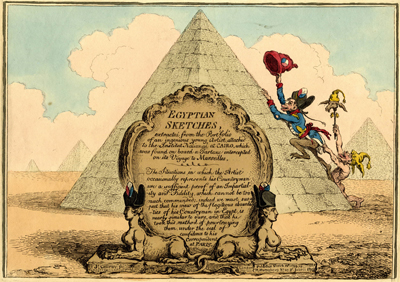Egyptian Sketches
This is the title page from a series of six "sketches" created by Gillray in response to the French invasion of Egypt by Napoleon Bonaparte that began in July 1798.
Taking off from an earlier print, Supposed to be a Correct Representation of a Mamaluke Chief where Gillray pretended that his work was derived from "a Sketch by a French Officer," Gillray here develops an even more elaborate persona. The six sketches that follow, he claims, are "extracted from the Portfolio of an ingenious young Artist, attached to the Institut National at Cairo, which was found on board a [French] Tartane intercepted on its Voyage to Marseilles."
By making his persona an artist attached to the new Institut (as opposed to a common French soldier), Gillray could develop a series of prints closer to his own level of artistic sophistication while at the same time claiming that they represent an accurate record of the French mission in Egypt. Indeed he could even congratulate the French artist for his "Impartiality and Fidelity," and imply that any perceived similarity to English perspectives is a result of the French artist's view of "the flagitious absurdities of his Countrymen in Egypt." And the very real fact that letters from French officers in Cairo had been recently intercepted by the British fleet provided a further hint of plausibility that Gillray must have enjoyed as he created the series.

© Trustees of the British Museum
The title page establishes the tone and perspective for the six prints that follow. The stone sphinxes in the foreground have already suffered the fate intended for the rest of the country. They have been at least superficially coopted by the French invaders and now wear the bicorne hats associated with the French army and the tri-color cockade associated with the revolutionaries. In the background a ragged sans-culotte French officer (portrayed as half human and half monkey) ascends the symbol of Egypt, a pyramid, to place a revolutionary bonnet rouge atop its apex.
But if the visual absurdity of all of this were not already apparent, the monkey-man is followed by a naked fool hanging on to his coat tails and waving a fool's marotte with an ass's head. In fact, the title page establishes "asses" as a kind of visual theme in the series; for asses appear in at least four of the seven total prints. Not surprisingly, then, the sketches that follow are closer to comic caricature than satire, portraying foolishness rather than evil. The series is almost unique in Gillray's work in its complete abstention from portrait caricature. And though visually arresting, the prints seem less complex than Gillray's satitric efforts which often cut several ways.
* "Mameluke" is spelled in a variety of ways both by Gillray and by historians, e.g. Mamaluke. Mameluke, Mamlouk, and Mamluk. In the text of my commentary, I will use Mameluke except where I am quoting from a source that spells it otherwise.
Sources and Reading
- Commentary from the British Museum on Egyptian Sketches.
- Tim Clayton & Sheila O'Connell, Bonaparte and the British, 2015, #28, p. 81.
- "French campaign in Egypt and Syria," Wikipedia
- The Napoleonic Invasion of Egypt
- Thomas Wright and R.H. Evans, Historical and Descriptive Account of the Caricatures of James Gillray #221
- Thomas Wright and Joseph Grego, The Works of James Gillray, the Caricaturist; With the History of His Life and Times p. 256.
Comments & Corrections
NOTE: Comments and/or corrections are always appreciated. To make that easier, I have included a form below that you can use. I promise never to share any of the info provided without your express permission.